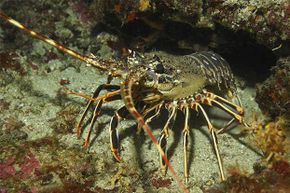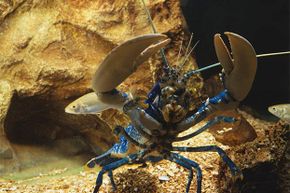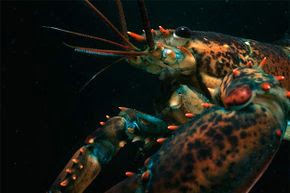Quck answer
Lobsters are fascinating creatures that have captured the attention of people for centuries. Here are 10 weird facts about lobsters that you might not know:
1. Lobsters have blue blood.
2. Lobsters can regenerate their limbs.
3. Lobsters have a special stomach for digesting food.
4. Lobsters can live up to 100 years.
5. Lobsters are cannibalistic.
6. Lobsters are not just red; they can be blue, yellow, or even albino.
7. Lobsters have teeth in their stomachs.
8. Lobsters communicate with each other through urine.
9. Lobsters have a unique way of mating.
10. Lobsters were once considered a poor man’s food, but are now considered a delicacy.
Wild Animals

Lobsters are a popular dish, but they have some strange habits and characteristics.
Photography by Bobi/Moment/Thinkstock
Lobsters are unusual creatures, with no vocal cords and two stomachs. They have also been known to eat each other.
Despite these oddities, people still enjoy the sweet, delicious meat found inside their shells. Lobster used to be considered a poor man’s food in New England, but it has since become a luxury item.
Let’s take a closer look at ten weird facts about lobsters, focusing primarily on the American or Maine lobster. Read on to discover how lobster went from a common food item to a delicacy.
10: Lobster Was Once Considered Poor Man’s Food

During the Middle Ages, lobsters were considered a delicacy and even used as medicine. However, by the 18th and 19th centuries in New England, lobsters were so plentiful that they were fed to pigs and used as fertilizer. Servants even won a court case to limit the number of times they were served lobster each week.
Jeffrey Greenberg/UIG via Getty Image
It wasn’t until wealthy city-dwellers tried lobster in the late 1800s that it became a luxury food item. Advances in refrigeration allowed live lobsters to be transported across the country, but as supply decreased, demand and prices increased.
9: Lobsters Aren’t Usually Red Before Cooking

In the wild, most lobsters are a greenish-brown color. They turn red when cooked because the heat breaks the bond between pigmentation and protein in the shell. The red color comes from a pigment called astaxanthin, which is found in the plants that lobsters eat.
Borut Furian/WaterFrame/Thinkstock
Some lobsters can be red, orange, yellow, green, blue, or a combination of colors before cooking. This is usually due to a genetic mutation or the food they eat. If a lobster only has one type of food available, it may turn a solid color as a result.
The American lobster with its large claws is commonly known, but its cousin, the European lobster, has smaller claws and is dark blue with spots and a yellow underbelly. Rock lobsters or spiny lobsters, without claws, are found in warmer waters around the world in a variety of colors. Lobsters have unique anatomical characteristics such as peeing from their faces, having two stomachs, and using their three pairs of antennae for seeing and navigating. The lobster’s urine contains pheromones that calm down and attract dominant males during mating rituals, and they also urinate in each others’ faces during fights to express themselves. The tomalley, the digestive gland that serves as a filtration system, is found in most of a lobster’s abdomen and is considered a delicacy by some.
6: Losing a Claw is Not a Big Deal

Lobsters have two different sized pincers, with the larger one being used for crushing through the shells of their prey and the smaller one for shredding meat. Lobsters have a dominant claw, which can be on either the left or right side, and the crusher claw can be on either side as well. If a lobster loses a claw or leg, it will grow another when molting. This process happens several times a year and any missing limbs regrow during this time. This is called autotomy or reflex amputation and is an adaptive phenomenon.
5: They Don’t Make Noise

Lobsters have no vocal chords and therefore cannot make any noise. Any sounds heard from a cooking pot are likely air escaping from the lobster’s shell. While it is debated whether or not lobsters feel pain, some researchers claim that they do not have a complex nervous system or brain like vertebrates do. However, others argue that they do feel pain. To ensure humane treatment of lobsters, some restaurants use a machine called a CrustaStun, which electrocutes the crustaceans to quickly kill them.
4: Lobster Relationships Only Last Two Weeks

Lobsters are known for their aggressive nature, and female lobsters tend to mate with the most dominant male in the vicinity. However, this does not lead to a lifelong commitment. The female visits the dominant male and entices him into mating by urinating in his shelter. After a few visits, the male gets the message and they mate. The female molts before mating and hangs around until she regrows her shell before leaving. The entire process takes about 10 days to two weeks. However, the dominant male will mate with other females who visit him, making them serial monogamists rather than lifelong partners.
2: Lobsters have a Cannibalistic Nature

Lobsters tend to eat their own kind, especially juveniles and those that have recently molted.
Jeff Rotman/The Image Bank/Getty Images
One of the reasons why baby lobsters have a low survival rate is because they often resort to eating each other. After hatching, lobsters go through several developmental stages and start competing for food such as crab, marine worms, starfish, and more. In close proximity, these juveniles tend to eat each other without any hesitation. This kind of behavior is why it is difficult to raise lobsters in captivity as they have to be kept separately [source: Anderson].
Adult lobsters also exhibit cannibalistic behavior, often preying on juveniles or those that have just molted when they are in traps or tanks. Until recently, researchers had not observed this behavior in the wild. However, in 2012, scientists in Maine filmed lobsters engaging in infanticide. They tethered a juvenile lobster, anticipating natural predators such as cod and skate to take advantage. However, adult lobsters fought over it at night. This behavior was attributed to a recent surge in lobster populations due to overfishing and warmer waters, which had reduced the number of natural predators [source: Doucleff].
1: Lobsters Don’t Show Signs of Aging

Isabel Schmalenbach, an environmental scientist, holds an adult female European lobster she is planning to release into the North Sea to help repopulate it.
Sean Gallup/Getty Image
There was a meme in the summer of 2013 that claimed lobsters were biologically immortal, which is not true. Lobsters age differently from most other animals – they do not lose their ability to reproduce or get weaker and will continue to molt and grow. However, this does not mean they live forever. At some point, even if they are not caught, they die of natural causes, often due to the loss of energy to molt, which leads to fatal diseases [source: Koren].
Although lobsters eventually die, their lifespan is yet to be determined. Lobsters become adults when they weigh between 1.5 to 2 pounds (680 to 907 grams), but some weigh as much as 44 pounds (20 kilograms) [source: BBC]. Scientists estimate that lobsters in the wild can live up to 50 years.
Researchers measure a lobster’s age by analyzing the accumulation of materials in its body over time, such as fat deposits in its eyestalks or a pigment called eurolipofuscin in its brain [source: Koren]. Recent research shows that counting age bands hidden inside the gastric mill in one of its stomachs may be the best way to estimate a lobster’s age [source: Poppick].
Additional Details
Writer’s Note: 10 Surprising Facts About Lobsters
While composing this piece, I found myself longing for a succulent lobster. However, I’ve never ordered one before since I fear that I might embarrass myself and other diners by accidentally making a mess. Though I enjoy cooking, I’ve never attempted to prepare a live, whole lobster myself. Although I believe that lobsters probably don’t feel much pain, I still feel a bit uneasy about cooking a live creature.
Other Articles of Interest
- Unbelievable Animal Facts: 10 Things You Never Knew
- 10 Incredible Abilities of the Animal Kingdom
- 10 Astonishing Behaviors in Nonhuman Creatures
- 10 Terrible Adaptations in the World of Animals
- 10 Misconceptions About Science That Everyone Believes
Sources
- Anderson, Genevieve. “Lobster Mariculture.” Santa Barbara City College. June 15, 2009. (July 15, 2014) http://www.marinebio.net/marinescience/06future/lobsterfarm.htm#top
- Baltimore Sun. “Lobsters are unlikely to feel pain, report says.” Feb. 18, 2005. (July 14, 2014) http://articles.baltimoresun.com/2005-02-18/news/0502180376_1_lobsters-feel-pain-animal-welfare
- BBC News. “Giant lobster landed by boy, 16.” June 26, 2002. (July 14, 2014) http://news.bbc.co.uk/2/hi/uk_news/england/kent/5118370.stm
- Cowan, Diane. “Ask the Lobster Doc.” The Lobster Conservancy. 2003. (July 14, 2014) http://www.lobsters.org/ldoc/ldocindx.php
- Cowan, Diane. Serial Monogamy in Homarus americanus.” Lobster Newsletter. July 1990. (July 16, 2014) http://www.lobstermanspage.net/lobstrs/articles/sermon1.html
- Cressey, Daniel. “Experiments reveal that crabs and lobsters feel pain.” Nature. Aug. 7, 2013. (July 14, 2014) http://blogs.nature.com/news/2013/08/experiments-reveal-that-crabs-and-lobsters-feel-pain.html
- Dembosky, April. “How lobster clawed its way up.” Mother Jones. March 2006. (July 14, 2014) http://www.motherjones.com/politics/2006/03/how-lobster-clawed-its-way
- Doucleff, Maureen. “Caught: Lobster Cannibals Captured On Film Along Maine Coast.” NPR. Dec. 3, 2012. (July 16, 2014) http://www.npr.org/blogs/thesalt/2012/12/03/166235228/caught-lobster-cannibals-captured-on-film-along-maine-coast
- Ellicot, Claire. “How to kill a lobster with kindness.” Daily Mail. Nov. 23, 2009. (July 15, 2014) http://www.dailymail.co.uk/femail/food/article-1230020/How-kill-lobster-kindness.html
- FDA. “FDA Advises Against Consumption of Tomalley from American Lobster (also known as “Maine Lobster”).” June 28, 2008 (July 28, 2014) http://www.fda.gov/NewsEvents/Newsroom/PressAnnouncements/2008/ucm116927.htm
- Gosselin, T., et al. “Geographic variation of multiple paternity in the American lobster, Homarus americanus.” Molecular Ecology. April 2005. (July 15, 2014) http://www.ncbi.nlm.nih.gov/pubmed/15813789
- Gulf of Maine Research Institute. “Kinds of Lobsters.” Feb. 27. 2012. (July 22, 2014) http://www.gma.org/lobsters/allaboutlobsters/species.html
- Koren, Marina. “Don’t Listen to the Buzz: Lobsters Aren’t Immortal.” Smithsonian. June 3, 2013. (July 14, 2014) http://www.smithsonianmag.com/science-nature/dont-listen-to-the-buzz-lobsters-arent-actually-immortal-88450872/
- Krulwich, Robert. “Long Live The Lobster: Forever Young?” NPR. June 16, 2007. (July 14, 2014) http://www.npr.org/templates/story/story.php?storyId=11382976
- Lobster Conservancy. “Lobster Biology.” 2004. (July 14, 2014) http://www.lobsters.org/tlcbio/biology.html
- Markey, Sean. “Unknown Life of Lobsters: Sex, Robots, and Beyond.” National Geographic Society. Aug. 24, 2004. (July 16, 2014) http://news.nationalgeographic.com/news/2004/08/0824_040824_lobster.html
- McCarthy, Erin. “25 Delicious Facts About Lobsters.” Mental Floss. 2014. (July 13, 2014) http://mentalfloss.com/article/57241/25-delicious-facts-about-lobsters
- NOAA Fisheries Service. “Lobster FAQ.” 2002. (July 13, 2014) http://www.nefsc.noaa.gov/faq/fishfaq7.htmlNational Geographic Society. “Lobster.” 2014. (July 14, 2014) http://animals.nationalgeographic.com/animals/invertebrates/lobster/
- Pelzel, Raquel. “How to Kill a Lobster.” July 7, 2007. (July 15, 2014) The Wall street Journal. http://online.wsj.com/news/articles/SB118375568129659493
- Poppick, Laura. “Tree Rings For Lobsters.” Science Magazine. Dec. 10, 2012. (July 15, 2014) http://news.sciencemag.org/earth/2012/12/tree-rings-lobsters
- Prisco, Joanna. “Cracking the Cost of Lobster.” ABC News. Aug. 22, 2013. (July 13, 2014) http://abcnews.go.com/Lifestyle/cracking-cost-lobster/story?id=20029609
- St. Lawrence Global Observatory. “American Lobster.” 2014. (July 14, 2014) http://slgo.ca/en/lobster/context/characteristics.html
- Viegas, Jennifer. “Mysterious, Colorful Lobsters Being Caught.” Discovery News. July 23, 2012. (July 14, 2014). http://news.discovery.com/animals/lobsters-colorful-maine-120723.htm
FAQ
1. What makes lobsters turn red when cooked?
Contrary to popular belief, lobsters aren’t actually red when they’re alive. The red color comes from a pigment called astaxanthin, which is found in the shells of the lobster. When the lobster is cooked, the heat causes the protein in the shell to break down and release the pigment, giving the lobster its characteristic red color.
2. Can lobsters really live forever?
No, lobsters don’t live forever, but they can live to be quite old. The oldest lobster on record was estimated to be around 140 years old. However, most lobsters don’t live nearly that long due to disease, predators, and fishing.
3. Why do lobsters have two different types of claws?
Lobsters have two different types of claws because they serve different purposes. The larger, bulkier claw is used for crushing and breaking shells, while the smaller, more slender claw is used for grasping and tearing apart prey.
4. How do lobsters communicate with each other?
Lobsters communicate with each other using a variety of methods, including chemical signals, sounds, and physical gestures. One of the most common ways they communicate is by urinating on each other, which helps them establish dominance and avoid fights.
5. Why do lobsters have blue blood?
Lobsters have blue blood because of a copper-based molecule called hemocyanin, which carries oxygen throughout their bodies. Hemocyanin contains copper, which gives the blood its blue color.
6. Can lobsters regenerate lost limbs?
Yes, lobsters have the ability to regenerate lost limbs, although it can take several molts for the limb to fully grow back. This is due to the fact that lobsters can shed their exoskeletons and grow new ones as they grow and mature.
7. How do lobsters navigate?
Lobsters navigate using a combination of their senses, including sight, smell, and touch. They also have a special organ called a statocyst that helps them maintain balance and orient themselves in the water.
8. What’s the difference between a lobster and a crayfish?
Lobsters and crayfish are both crustaceans, but they belong to different families. Lobsters are typically larger and found in saltwater, while crayfish are smaller and found in freshwater. Additionally, lobsters have two large claws, while crayfish have smaller, more numerous claws.
9. Why do lobsters have such long antennae?
Lobsters have long antennae that serve several purposes, including sensing their surroundings, detecting predators, and finding food. They are also used for communication and courtship, as lobsters can use their antennae to touch and “smell” each other.
10. Can lobsters feel pain?
This is a controversial topic, but some studies have suggested that lobsters are capable of feeling pain. However, it’s important to note that they don’t experience pain in the same way that humans do, as their nervous systems are much simpler. Additionally, many methods of cooking lobsters involve killing them quickly and efficiently to minimize any potential pain or suffering.





Leave a Reply